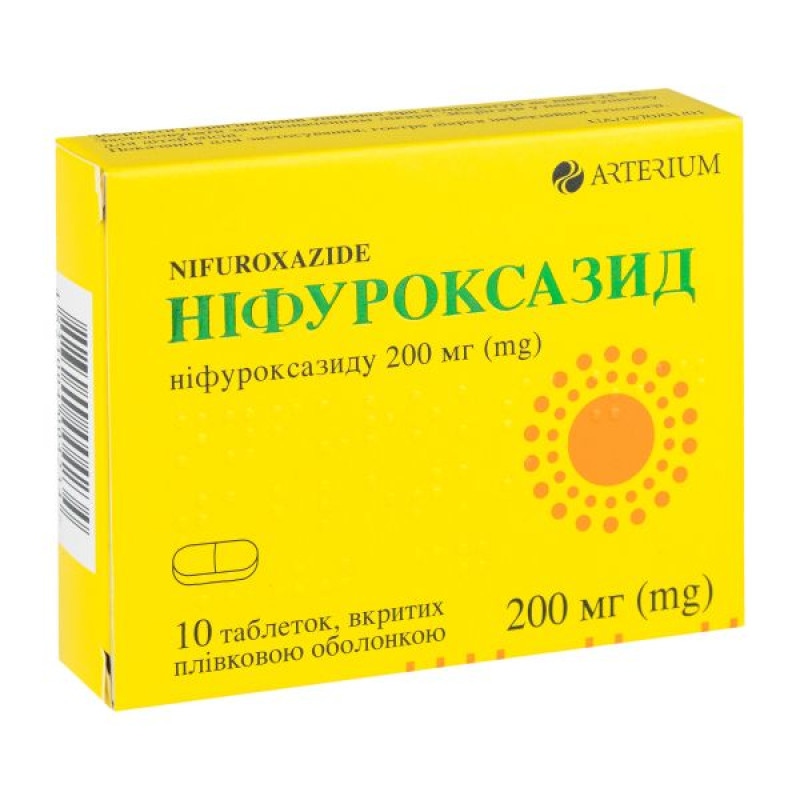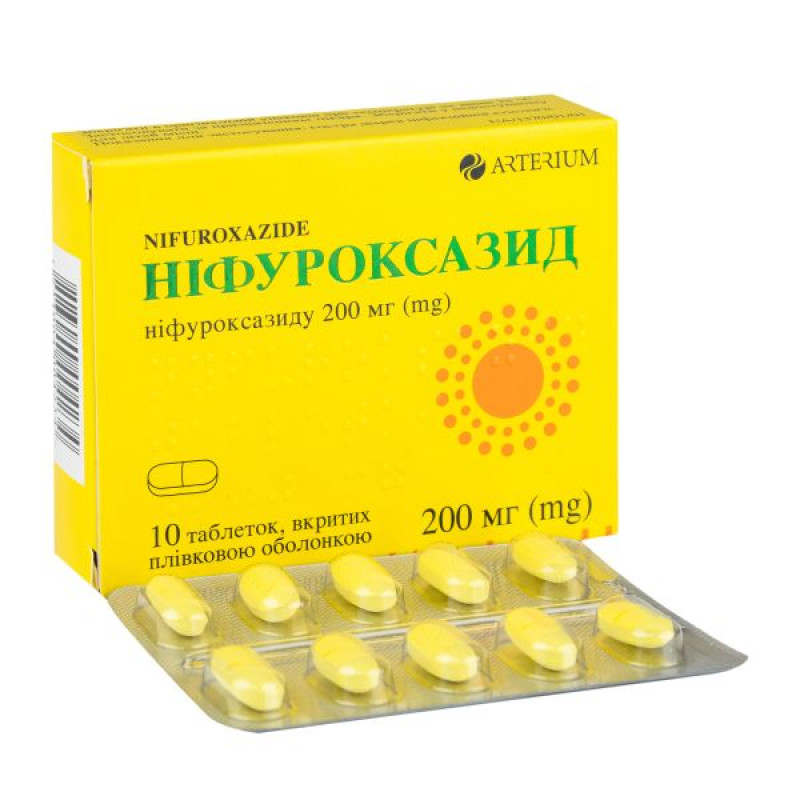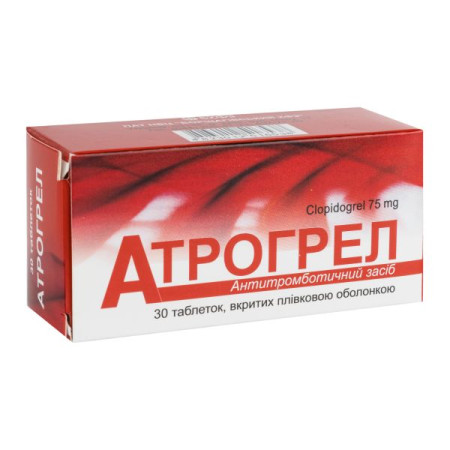Nifuroxazide film-coated tablets 200 mg No. 10

Instructions Nifuroxazide film-coated tablets 200 mg No. 10
Warehouse
active ingredient: nifuroxazide;
1 tablet contains: nifuroxazide in terms of 100% substance – 200 mg;
excipients: microcrystalline cellulose; povidone; lactose, monohydrate; calcium stearate; coating mixture "Opadry II Yellow" 33G22623, containing: hypromellose; lactose, monohydrate; titanium dioxide (E 171); polyethylene glycol 3000 (macrogol); triacetin; quinoline yellow (E 104); sunset yellow FCF (E 110); iron oxide yellow (E 172); indigo carmine (E 132).
Dosage form
Film-coated tablets.
Main physicochemical properties: yellow film-coated tablets, oval in shape, with a biconvex surface, with a score on one side of the tablet and the inscription "KMP" on the other side. A bright yellow core is visible when broken.
Pharmacotherapeutic group
Antimicrobial agents used for intestinal infections. Nifuroxazide. ATC code A07A X03.
Pharmacological properties
Pharmacodynamics.
Nifuroxazide is an antimicrobial agent of the 5-nitrofuran group, belongs to intestinal antiseptics. Blocks the activity of dehydrogenases, inhibits cellular respiration, the tricarboxylic acid cycle, and also disrupts protein synthesis in the microbial cell. Reduces the production of toxins by microorganisms. In medium therapeutic doses, it exhibits bacteriostatic activity, and in higher doses, it has a bactericidal effect.
The drug is active against gram-positive microorganisms of the Staphylococcus family and gram-negative microorganisms of the Enterobacteriaceae family (Escherichia, Enterobacter, Salmonella, Shigella). It is inactive against bacteria of the genus Pseudomonas and the genus Proteus (species Proteus inconstans), as well as strains of subgroup A of the Providentia alcalifaciens species.
Pharmacokinetics.
After oral administration, nifuroxazide is not absorbed from the digestive tract, providing a high concentration of the active substance in the intestine. Trace concentrations of the drug are determined in blood plasma; a small amount is found in the urine in unchanged form. It is excreted in the feces. The rate of drug excretion depends on the dose of the drug used and the motility of the digestive tract.
Indication
Infectious diarrhea, chronic colitis and enterocolitis of infectious etiology, as part of the complex treatment of intestinal dysbiosis syndrome; prevention of infectious complications of the gastrointestinal tract during surgical interventions.
Contraindication
Hypersensitivity to 5-nitrofuran derivatives and/or to other components of the drug.
Interaction with other drugs and other types of interactions.
During treatment with nifuroxazide, it is contraindicated to consume alcohol and drugs containing it due to the possibility of developing disulfiram-like reactions, which are manifested by a feeling of heat, skin hyperemia, tinnitus, difficulty breathing, tachycardia, and a feeling of fear.
Simultaneous (at the same time) administration of other oral medications should be avoided due to the strong adsorption properties of nifuroxazide.
Application features
Nifuroxazide is not recommended for use for longer than 7 days. In case of diarrhea lasting more than 3 days from the start of treatment, in-depth diagnostics are necessary to determine the cause of the symptoms. Antibiotic therapy may be necessary.
The drug should not be prescribed as monotherapy for the treatment of intestinal infections complicated by septicemia. If there are symptoms of dehydration, rehydration should be carried out in combination with the use of nifuroxazide.
In case of severe invasive diarrhea, an antibiotic should be administered because nifuroxazide is not absorbed from the gastrointestinal tract.
In case of hypersensitivity reactions (shortness of breath, skin rashes, itching), nifuroxazide should be discontinued.
During treatment, you should follow a certain diet: exclude juices, fresh vegetables and fruits, spicy and difficult to digest foods.
This medicine contains lactose. Patients with rare hereditary problems of galactose intolerance, the Lapp lactase deficiency or glucose-galactose malabsorption should not take this medicine.
Do not exceed the recommended dose of the drug.
Use during pregnancy or breastfeeding
The use of the drug during pregnancy is possible if the expected positive effect for the mother outweighs the potential risk to the fetus.
It is known that nifuroxazide is not absorbed from the gastrointestinal tract and does not penetrate into breast milk, but due to the lack of sufficient clinical data, caution should be exercised when prescribing the drug during breastfeeding.
Ability to influence reaction speed when driving vehicles or other mechanisms
Nifuroxazide does not affect the reaction rate when driving or working with other mechanisms.
Method of administration and doses.
Nifuroxazide should be taken orally, regardless of meals.
Adults and children over 7 years old - 1 tablet (200 mg) 3-4 times a day (daily dose - 600-800 mg).
Children. Nifuroxazide, 200 mg tablets should be used in children over 7 years of age. Children under 7 years of age should be prescribed nifuroxazide in a different dosage form.
Overdose
Symptoms of overdose are unknown. In case of overdose, gastric lavage and symptomatic treatment are recommended.
Adverse reactions
Occasionally, disorders of organs and systems may occur:
From the side of the hematopoietic and lymphatic system: one case of granulocytopenia has been described.
On the part of the digestive tract: individual hypersensitivity reactions to nifuroxazide are manifested by abdominal pain, nausea, vomiting and exacerbation of diarrhea. In the event of the appearance of such symptoms of minor intensity, there is no need to use special therapy or discontinue the use of nifuroxazide, since the symptoms quickly subside. If the exacerbation is severe, nifuroxazide should be discontinued. In the future, the patient should avoid taking nifuroxazide and other nitrofuran derivatives.
Allergic reactions, usually of the skin type (rash, itching, urticaria, pustulosis), are possible. In rare cases, shortness of breath, severe hypersensitivity reactions, including angioedema and anaphylactic shock, may occur.
The drug contains the dye sunset yellow FCF (E 110), which may cause allergic reactions.
Expiration date
3 years.
Storage conditions
Store in the original packaging, at a temperature not exceeding 25 ºС.
Keep out of reach of children.
Packaging
10 tablets in a blister, 1 or 2 blisters in a pack.
Vacation category
According to the recipe.
Producer
PJSC "Kyivmedpreparat".
Location of the manufacturer and its address of place of business. Ukraine, 01032, Kyiv, Saksaganskoho St., 139.
There are no reviews for this product.
There are no reviews for this product, be the first to leave your review.
No questions about this product, be the first and ask your question.










